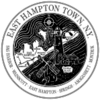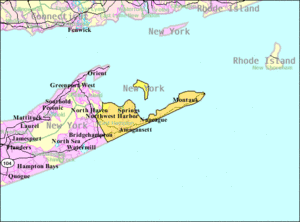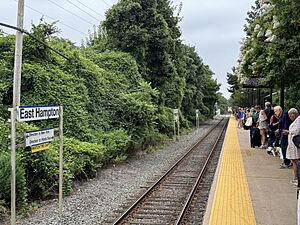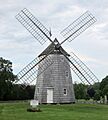East Hampton, New York facts for kids
Quick facts for kids
East Hampton, New York
|
||
|---|---|---|
| Town of East Hampton | ||
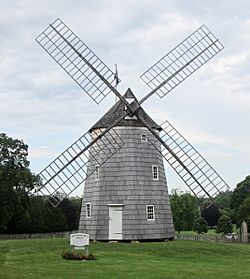
Hook Mill
|
||
|
||

Location in Suffolk County
|
||
| Country | United States | |
| State | New York | |
| County | Suffolk | |
| Government | ||
| • Type | Town | |
| Area | ||
| • Total | 386.57 sq mi (1,001.21 km2) | |
| • Land | 74.33 sq mi (192.52 km2) | |
| • Water | 312.24 sq mi (808.70 km2) | |
| Elevation | 33 ft (10 m) | |
| Population
(2020)
|
||
| • Total | 28,385 | |
| • Density | 381.87/sq mi (147.44/km2) | |
| Time zone | UTC−05:00 (Eastern (EST)) | |
| • Summer (DST) | UTC−04:00 (EDT) | |
| ZIP Code |
11937
|
|
| Area code(s) | 631 | |
| FIPS code | 36-22194 | |
| GNIS feature ID | 978919 | |
The Town of East Hampton is a cool place located at the eastern end of Long Island in New York. It's the easternmost town in the entire state! In 2020, about 28,385 people lived here.
East Hampton is like a peninsula, surrounded by water on three sides. The Atlantic Ocean is to the south, Block Island Sound to the east, and Gardiners Bay to the north. It's a great spot for water activities!
The town includes the village of East Hampton. It also has smaller areas called hamlets like Montauk, Amagansett, Wainscott, and Springs. Part of the village of Sag Harbor is also in East Hampton.
East Hampton covers about 74 square miles (192 square kilometers) of land. It stretches almost 25 miles (40 km) from west to east. The town also looks after Gardiners Island, which is one of the biggest privately owned islands in the United States.
Contents
History of East Hampton
Native American History in East Hampton
For thousands of years, different groups of indigenous peoples lived in the East Hampton area. When Europeans first arrived, the Pequot people lived here. They were part of a larger group that also lived across the water in what is now Connecticut. These groups spoke Algonquian languages.
The people living at the east end of Long Island were known as the Montaukett. Another group, the Lenape, lived in the western part of Long Island.
In the late 1600s, a Montaukett leader named Chief Wyandanch talked with English settlers about land. The Montaukett and the English had different ideas about land ownership. This led to the Montaukett losing most of their lands over time.
For example, Chief Wyandanch's older brother, Poggaticut, sold an island to an English settler named Lion Gardiner. He traded it for things like a large black dog, some gunpowder, and blankets. Later, land from present-day Southampton to Hither Hills State Park was traded for hatchets, coats, mirrors, and tools.
In 1660, Chief Wyandanch's widow signed away the rest of the land to the tip of Montauk Point. This was for 100 pounds, paid in corn or wampum. The agreement allowed the Montaukett to stay on the land, hunt, fish, and use whales that washed ashore. However, the settlers gradually stopped them from doing this.
Many Montaukett people became sick and died from diseases like smallpox. These diseases were new to them and they had no natural protection. After the American Revolution, some Montaukett moved to western New York with other Native American groups. They formed the Brothertown Indians and later moved to Wisconsin.
Some Montaukett stayed on Long Island. A famous member in the 1800s was Stephen Talkhouse. Their land near Lake Montauk was called Indian Fields. When a man named Arthur W. Benson bought most of the east end of the town, he asked the Montaukett to leave. They moved to Freetown, a community started by free people of color.
The Montaukett tried to get their land back through the courts, but they were not successful. Today, the Montaukett are still working to be officially recognized as a tribe. You can see some Montaukett artifacts and old structures at Theodore Roosevelt County Park.
Early European Settlers
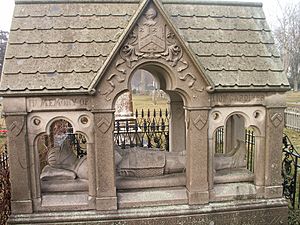
East Hampton was the first English settlement in New York state. In 1639, Lion Gardiner bought land that became Gardiner's Island from the Montaukett people. This island was its own colony until after the American Revolution. Then it became part of New York State and East Hampton.
On June 12, 1640, nine families from Lynn, Massachusetts landed in what is now Southampton. Some of them later moved to East Hampton. These first English settlers included John Hand, Thomas Talmage, and William Hedges.
The Mulford Farmhouse is a very old English colonial house in East Hampton. It was built in 1680 and is now a living museum. This house is listed on the National Register of Historic Places.
East Hampton was first called Maidstone, after a town in England. Later, its name was changed to "Easthampton" to match nearby towns like Southampton. In 1885, the local newspaper started using "East Hampton" as two words, and the name stuck!
Did you know that Deep Hollow Ranch in Montauk, started in 1658, is the oldest cattle ranch in the United States that's still running?
Geography of East Hampton
East Hampton is bordered by Southampton to the west. The Atlantic Ocean is to the south, Block Island Sound to the east, and Napeague Bay to the north.
The town covers about 386.6 square miles (1001.2 square kilometers) in total. Most of this area, about 80%, is water!
Climate in East Hampton
East Hampton has a mild climate because it's near the ocean. Winters are cool and wet, while summers are warm and sunny. The ocean helps keep temperatures from getting too extreme. It doesn't snow much here, usually only about 10 inches (25 cm) each year.
People of East Hampton
In 2010, there were 21,457 people living in East Hampton. Many houses in East Hampton are second homes for people, including some very wealthy families. The local economy relies on shops and services that support these residents.
The population of East Hampton has grown a lot over the years. In 1790, there were about 1,497 people. By 2020, it had grown to 28,385 people.
Fun Events in East Hampton
East Hampton has some cool events throughout the year:
- The East Hampton Fire Department usually puts on a fireworks show at Main Beach around July 4. Sometimes, it's moved to Labor Day weekend to protect nesting birds called piping plovers.
- The Artists and Writers Softball Game is a fun charity event held every summer. Famous people like John Irving, Norman Mailer, and singer Paul Simon have played in it.
- Every October, the town hosts the Hamptons International Film Festival. This event shows independent movies and brings many visitors from New York City.
Communities and Places to Know
Villages (incorporated)
- East Hampton
- Sag Harbor (part of this village is also in the Town of Southampton)
Hamlets (unincorporated)
Special Areas
- East Hampton North: This area is just north of the village. It's known locally as Freetown because it was founded by free people of color in the 1800s.
- Northwest Harbor: This area is northwest of the village and is often called "Northwest" or "Northwest Woods." It has a harbor.
Parks to Explore
There are many great parks in East Hampton:
- Amsterdam Beach State Park
- Camp Hero State Park
- Hither Hills State Park
- Montauk Downs State Park
- Montauk Point State Park
- Napeague State Park
- Sag Harbor State Golf Course
- Shadmoor State Park
- Cedar Point County Park
- Theodore Roosevelt County Park
Education in East Hampton
East Hampton has several schools for students:
- East Hampton High School: This is the main high school for most of the town. Its mascot is the Bonackers!
- Pierson Middle-High School: This school is in East Hampton but serves students from Sag Harbor. Their mascot is the Whalers.
- Ross School: This is a private school that teaches students from pre-school all the way through 12th grade.
An important American educator named Catharine Beecher was born in East Hampton.
Getting Around East Hampton
Train Travel
The Long Island Rail Road has a line called the Montauk Branch that runs through East Hampton. You can catch a train at stations in East Hampton, Amagansett, and Montauk.
Bus Services
You can use Suffolk County Transit buses to get around town. If you want to go to New York City, you can take a Hampton Jitney bus.
Main Roads
Here are some of the important roads in East Hampton:
Airports
East Hampton has two airports:
- East Hampton Airport
- Montauk Airport
Ferries
You can take a passenger ferry from Montauk Harbor across the Block Island Sound. These ferries can take you to Block Island, New London, or Oak Bluffs on Martha's Vineyard.
Images for kids
See also
 In Spanish: East Hampton (Nueva York) para niños
In Spanish: East Hampton (Nueva York) para niños


